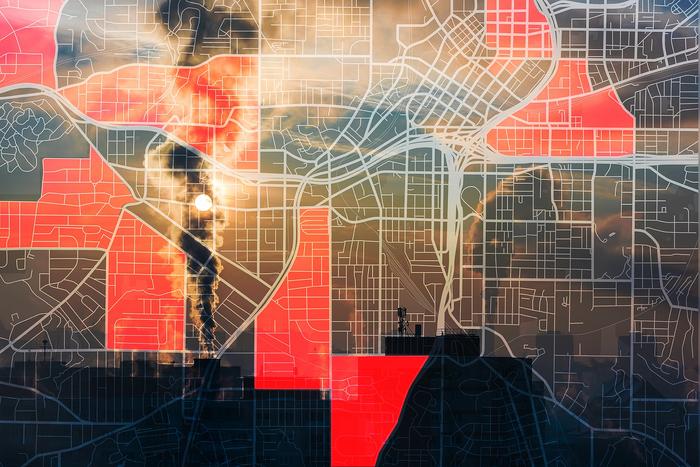BUFFALO, N.Y. — Air pollution is bad for mental health. That much is clear. Now, new research shows the impact may be even worse in neighborhoods that were historically redlined.

Credit: University at Buffalo
BUFFALO, N.Y. — Air pollution is bad for mental health. That much is clear. Now, new research shows the impact may be even worse in neighborhoods that were historically redlined.
University at Buffalo researchers looked at 17 cities across New York State where longstanding federal housing policies once denied neighborhoods with people of color from receiving mortgages. Although this practice was outlawed in 1968, the researchers found that elevated levels of air pollutants in these neighborhoods of the state are disproportionately linked to increased emergency room (ER) visits for mental disorders.
“There was a significant association between air pollutant exposure and ER visits throughout these cities’ various neighborhoods, but it was most pronounced in their redlined communities, negatively impacting the vulnerable population that still lives there,” says Eun-Hye Enki Yoo, PhD, associate professor of geography in the UB College of Arts and Sciences.
Yoo is the lead author of the study, which will be featured in the Oct. 20 issue of Science of the Total Environment.
Linking pollution to ER visits
Redlining came about from New Deal-era government-insured mortgages. The Federal Housing Administration (FHA) rated communities’ lending risk from “A” to “D,” with D being considered the most risky and colored red on color-coded maps. These D-rated — or redlined — neighborhoods, not coincidentally, had higher populations of non-white residents, as the FHA concluded that homes near Black residents might lose property value.
Research has found that D-rated neighborhoods to this day have worse air quality, caused by proximity to industry and highways, and worse mental health, among other poor health outcomes.
“So the next logical question was whether these mental health outcomes are due, at least in part, to harmful environmental exposures,” says the study’s co-author, John Roberts, PhD, associate professor of psychology and associate director of clinical training in the UB Department of Psychology.
Elevated levels of pollutants are considered risk factors for anxiety, depression, schizophrenia, substance abuse disorders and dementia, but to substantiate a direct link, Yoo and Roberts collected deidentified New York State Department of Health patient records from 2005-16 and compared the data to daily air quality predictions by machine learning models. They focused on 17 cities where the federal government drew redlining maps, including Buffalo, Niagara Falls, Rochester, Albany and the boroughs of New York City.
They found that when levels of two pollutants, fine particulate matter and nitrogen dioxide, were elevated in D-rated neighborhoods, mental disorder-related ER visits there increased 1.04% and 0.44%, respectively, two days later.
Meanwhile, in A-rated neighborhoods, those the FHA once considered least risky, there was no association between elevated pollutants and subsequent increased ER visits.
However, the researchers note that the sample size for the A-rated neighborhoods was low, so they also compared the combined data of A- and B-rated neighborhoods with the combined data of C- and D-rated neighborhoods. While particulate matter had a significant effect on ER visits in both neighborhood groups, nitrogen dioxide, a gas associated with the burning of fossil fuels, did not have such an effect on the A and B group.
“Of course, there are many reasons, including social determinants of health, why there are more ER visits in one particular area than another, but we have methods, such as case-crossover design, that allows us to control for preexisting conditions and socioeconomic status,” Yoo says. “So the data showed rather conclusively that redlined neighborhoods bear the brunt of air pollution-induced mental health problems.”
The study also found that the association between elevated pollutants and increased ER visits only occurred during medium temperatures, 40 to 70 degrees Fahrenheit, and that
children under 18 and adults aged 35–64 were more susceptible to having air pollutants impact their mental health.
“Both these findings suggest being outdoors is a major factor in pollutant exposure, as people tend to be outside most during mild-weather days and younger people tend to be outside more than older people,” Yoo says.
Studies of Buffalo and beyond up next
Yoo has a $499,963 grant from the U.S. Environmental Protection Agency to install 30 air monitors across Buffalo’s East Side, a predominantly Black community with disproportionately negative health outcomes. It aims to provide even more accurate and localized air quality data than those provided by the predictive models in the current study.
Yoo is also collaborating with Oregon Health and Science University to analyze air pollution and mental health in historically redlined neighborhoods across the country.
“New York is not necessarily representative of the entire United States, so we’re excited to extend the framework of this study to a national analysis,” Yoo says. “We hope that more direct evidence may lead to policy change to do something about this problem.”
Journal
Science of The Total Environment
Method of Research
Data/statistical analysis
Subject of Research
Not applicable
Article Title
Differential effects of air pollution exposure on mental health: Historical redlining in New York State
Article Publication Date
14-Jul-2024



